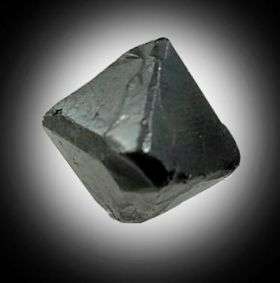Magnetism loses under pressure

Scientists have discovered that the magnetic strength of magnetite—the most abundant magnetic mineral on Earth—declines drastically when put under pressure. Researchers from the Carnegie Institution’s Geophysical Laboratory, together with colleagues at the Advanced Photon Source of Argonne National Laboratory, have found that when magnetite is subjected to pressures between 120,000 and 160,000 times atmospheric pressure its magnetic strength declines by half. They discovered that the change is due to what is called electron spin pairing.
Magnetism comes from unpaired electrons in magnetic materials. The strength of a magnet is a result of the spin of unpaired electrons and how the spins of different electrons are aligned with one another. This research showed that the drop in magnetism was due to a decrease in the number of unpaired electrons.
“Magnetite is found in small quantities in certain bacteria, in brains of some birds and insects, and even in humans,” commented Yang Ding, the study’s lead author with the Carnegie-led High-Pressure Synergetic Consortium. “Early navigators used it to find the magnetic North Pole and birds use it for their navigation. And now it is used in nanotechnology. There is intense scientific interest in its properties. Understanding the behavior of magnetite is difficult because the strong interaction among its electrons complicates its electronic structure and magnetic properties.”
To study the mineral, the researchers developed and applied a novel technique, called X-ray Magnetic Circular Dichroism (XMCD) at the Advanced Photon Source, a high-energy synchrotron facility. The technique uses high-brilliance circularly polarized X-rays to probe the magnetic state of magnetite as a diamond anvil cell subjects a sample to many hundreds of thousands of atmospheres. The researchers combined their experimental results with theoretical calculations by collaborators to pinpoint why the magnetic strength changes. The study, to be published in February in ������Ƶical Review Letters, reveals the electron-spin configuration in the iron sites of the mineral to be the origin of the phenomenon.
This discovery not only shows the profound effects of pressure on magnetism, it also discloses, for the first time, that pressure induced a spin pairing transition that results in changes in the electron mobility and structure.
“The discovery is important,” Ding said. “It advances our understanding of the correlation of magnetism, electron transport, and structural stability in materials with strong electron interactions, like magnetite.”
Source: Carnegie Institution





















